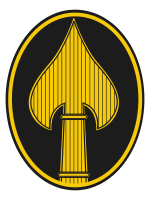 OSS insignia [1] | |
| Agency overview | |
|---|---|
| Formed | June 10, 1942 |
| Dissolved | September 20, 1945 |
| Superseding agencies | |
| Parent department | Office of Strategic Services |
The Maritime Unit (MU) was a branch of the Office of Strategic Services that enabled maritime warfare for the allies during World War II. [2] MU's mission was to "infiltrate agents and supply resistance groups by sea, conduct maritime sabotage, and to develop specialized maritime surface and subsurface equipment and devices." [2] MU developed specialized boats, equipment, and explosives, fashioned underwater breathing gear, waterproof watches and compasses, an inflatable motorized surfboard, and "a two-man kayak that proved so promising that 275 were ordered by the British." [3]
Contents
MU was originally established as a division of the Special Operations Branch of the OSS but was granted Branch status on June 10, 1942. [4]
The Frogmen of the MU are considered pioneers of amphibious, maritime, and underwater warfare. While it was a civilian agency, the United States Navy SEALS state clearly that the OSS Maritime Unit is one of their direct preceding organizations.

MU planned and carried out the amphibious phases of OSS activities and assisted in the development of the special equipment required. [5] If operations included water, the shoreline, coastal areas, or water approaches, then MU techniques were used. [5]
Those techniques were clandestine ferrying, maritime sabotage, and beach and hydrographic reconnaissance. [5]
The last living Frogman of the OSS was Henry “Hank” Weldon. [6] [7]

